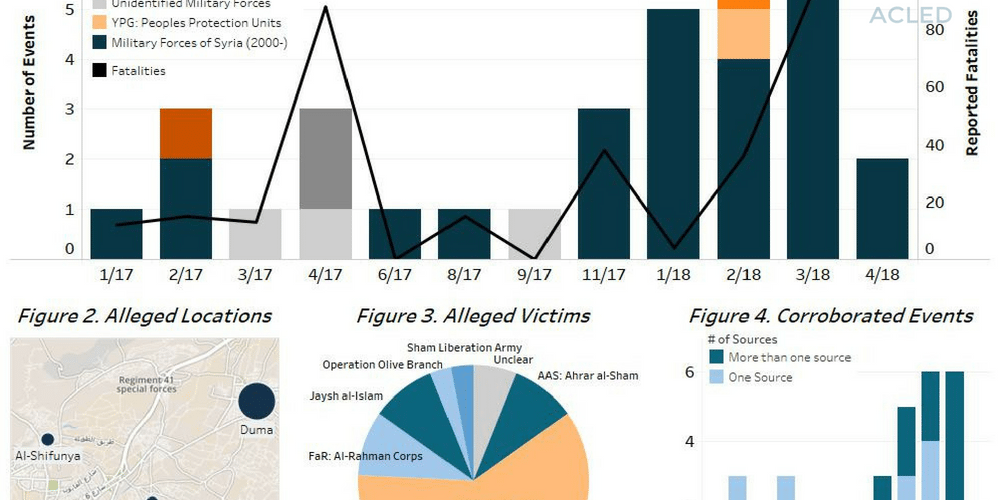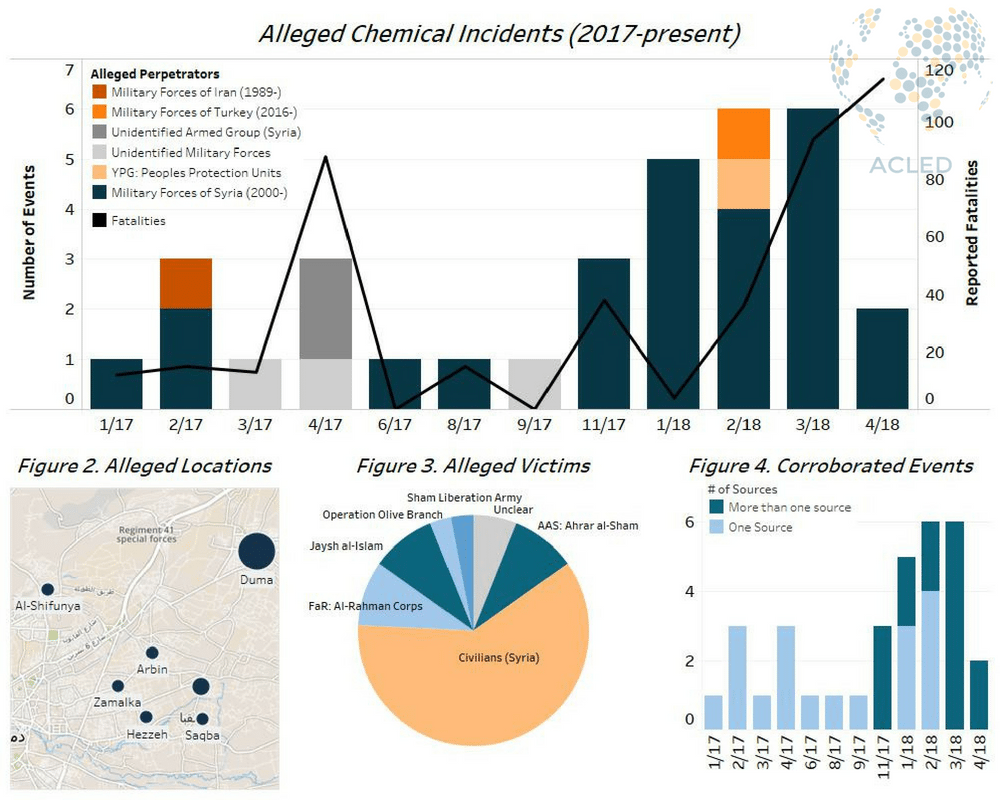Chemical incidents have perhaps been the only consistent factor shaping the United States’ position on the civil war in Syria before and after Trump’s election. A chemical attack on Eastern Ghouta in August 2013 prompted an imminent attack, led by the Obama administration. This was staved off by the Assad regime in an exchange for giving up its chemical stockpiles. But in April 2017, the regime hit Khan Sheikhoun prompting the Trump administration to bomb Shayrat Air Base. In April 2018, Duma was hit by yet another chemical attack leading to another bombardment by the US (and its allies).
It should be noted that these three chemical weapon incidents are just the tip of iceberg.[1] The Independent International Commission of Inquiry on Syria has verified 34 incidents since 2013 (while noting there are more). In the UN Security Council, the US recently claimed there have been 50 incidents. Human Rights Watch reported in 2017 that 85 chemical incidents took place in Syria. The French Foreign Ministry (whose intelligence position in Syria gives it access to evidence) has put the number of attacks at 130. The Syrian Archive – and ACLED partner – has documented 212 chemical attacks since 2012 (of which 26 in 2017 and five in 2018). ACLED data is collected from 2017 onwards and underscores the findings of the Syrian Archive. Moreover, we report an even higher number of potential chemical incidents for 2018 (19 incidents rather than five).
Figure 1 highlights reported incidents of suffocation, pupil dilatation, breathing difficulties and claims of usage of chlorine (eleven incidents in 2017, eight in 2018), Sarin (zero incidents) and other chemical agents (14 incidents).[2] As evidenced from these data, the number of potential chemical incidents and associated estimated fatalities in those incidents has increased in the first month of 2018.[3] Figures 1, 2 and 3 highlight that all incidents took place in and around Damascus; were carried out by the regime; and were predominantly aimed at civilians. In 2018, two potential incidents were reported near the Turkish border where both Turkish and YPG fighters were accused of firing a shell with a chemical agent.
The main question is how reliable are our reports on potential chemical incidents? One important reason for doubt is that belligerents are known to report chemical incidents by opponents to discredit them. Therefore, verification of chemical incidents through the Syrian Archive, or similar organizations, is necessary. While detailed verification is beyond our mission statement, we do however measure the likelihood that events occurred. Our benchmark is that events are reported by more than one source have a higher likelihood to be correct (see here and here for motivation). We find that potential incidents involving chemical agents in 2018 have a higher likelihood to have occurred than those in 2017 (see figure 4 – most incidents are reported by more than one source). This suggests that verification may very well corroborate our reported potential chemical incidents.
Returning to the United States’ policy on chemical weapons in Syria: If there is any lesson to learn it is that decisive action against any new incident (however small) will be needed. The large-scale attack on Duma was preceded by a number of smaller incidents in the months prior to the attack. The danger is that the April 13 bombardment has only temporarily prevented the usage of chemical agents–just as in 2017 when no chemical incidents were reported for three months after the retaliatory bombardment. Our data are a warning that swift action will be needed when new reports start to indicate an increased rate of attack. With every new chemical attack, the global norm against using chemical weapons will further erode.
[1] In Syria the most commonly used substances by the Regime are Sarin (a nerve gas – schedule 1) and Chlorine (leading to suffocation – schedule 2) while a smaller amount is ‘undetected’ (e.g. like Isopropanol). The OPCW has declared that 100% of the regime’s declared (!) Schedule 1 chemicals and 70% of Schedule 2 chemicals have been destroyed (destruction of chemical agents in Syria are the main explanation of the upward trend in global chemical weapons destruction). The figures are likely to be incorrect because Syria did not declare everything. Moreover, possession of Chlorine is not forbidden because it has many civil applications; only using it as a weapon is prohibited.
[2] An extract of the data can be downloaded here. Data obtained via a keyword search in the notes of ‘suffocation’ ‘Gas’ ‘Chlorine’, and ‘Chemical’ and a manual control afterwards.
[3] Do note that were are likely to miss information on 2017 as not all of our sources are published yet.
AnalysisCivilians At RiskConflict MonitoringCurrent HotspotsEthnic MilitiasFocus On MilitiasGovernment RepressionMiddle EastPolitical StabilityPro-Government MilitiasRemote ViolenceUnidentified Armed GroupsVigilante MilitiasViolence Against Civilians






